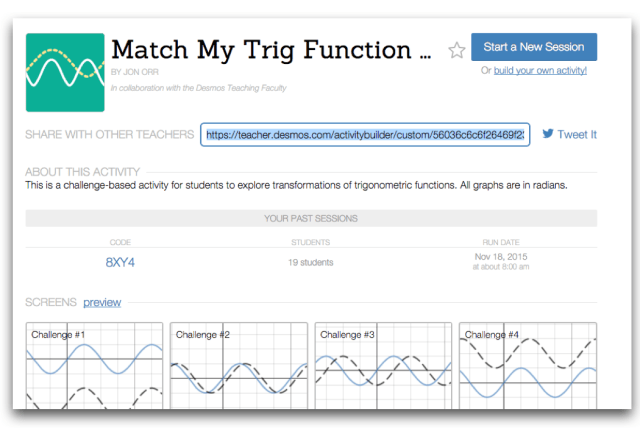Here’s a quick synapsis of an activity from my Advanced Functions class with transformations of trig functions.
We used a Custom Polygraph from Desmos to generate talk/discussion on key properties of trig functions (Students have previously dealt with trig functions in grade 11).
I overheard students asking questions about x-intercepts, period, and amplitude. Awesome!
We took a note on key properties of the sine function and cosine function (We ran out of time for Tangent). 
Let the struggle begin!
Students were then asked to work through this Match My Trig Function Activity built using Desmos’ Activity Builder.
Each slide is set up as a challenge. They are to write a sinusoidal function that “overlaps” the black target function. Students will have to use their memory or trial and error to discover how the parameters change the graph.
Matching trig function challenges in @Desmos pic.twitter.com/1kMqJBixVx
— Jon Orr (@MrOrr_geek) November 20, 2015
Watching the dashboard I can ensure their struggle is productive. I can jump in with feedback when I see they need it.
Here’s the best part, once they completed all 12 challenges they created their own trig function matching challenge and shared it out on a Padlet board. We had crowd sourced a bank of challenges to work through! The students didn’t hold back either… They wanted to create hard ones to push their friends.
See the challenge – Live Board Below
Can’t see this board? Click here
That’s where class ended. When we came in the next day and they all choose at least 5 peer challenges to complete…. And that’s when the taunting began!
To end it off we took a note based on their discoveries of how the parameters changed the graphs.
Click here to create your own Custom Activity Builder or here to create your own Padlet board.


























 This summer while at the Apple Distinguished Educator Institute in Miami I started a project that would create a digital resource that would link the Modelling Functions with Art Project with function challenges created by
This summer while at the Apple Distinguished Educator Institute in Miami I started a project that would create a digital resource that would link the Modelling Functions with Art Project with function challenges created by 













